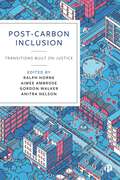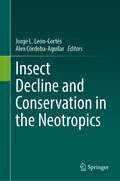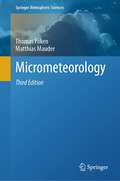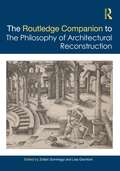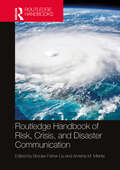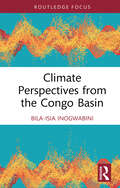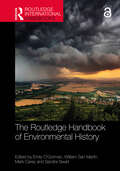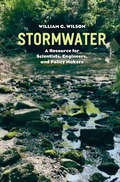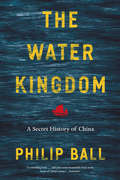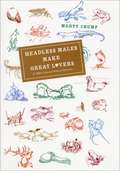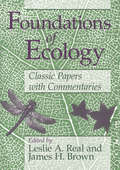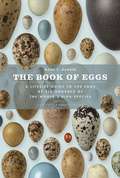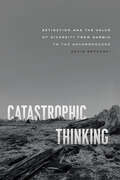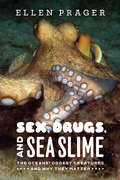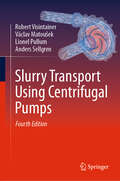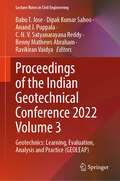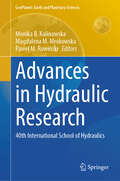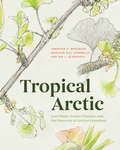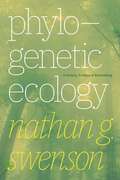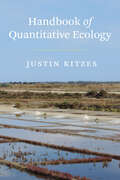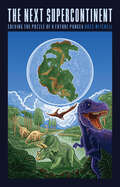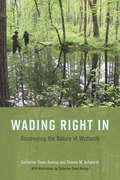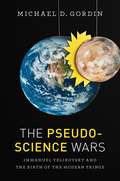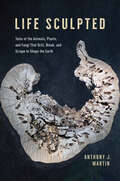- Table View
- List View
Post-Carbon Inclusion: Transitions Built on Justice
by Ralph Horne, Aimee Ambrose, Gordon Walker and Anitra NelsonThis collection pays unique attention to the highly challenging problems of addressing inequality within decarbonisation – particularly under-explored aspects, such as high consumption, degrowth approaches and perverse outcomes. Contributors point out means and possibilities of the transition from high carbon inequalities to post-carbon inclusion. They apply a variety of conceptual and methodological approaches in all-inclusive ways to diverse challenges, such as urban heating and retrofitting. Richly illustrated with case studies from the city to the household, this book critically examines ‘just transitions’ to achieve sustainable societies in the future.
Insect Decline and Conservation in the Neotropics
by Jorge L. León-Cortés Alex Córdoba-AguilarThis book provides for the first time an integrative analysis of the major drivers of decline and threats of insects and related arthropods in the Neotropical region. Thus, it is an urgent first step towards filling an information gap in this region. It identifies the main causes of decline, provides and discusses examples from the better-studied insect faunas to develop and advance principles and practical conservation management for the rich Neotropical insect faunas. The book is aimed at students, naturalists, environmental managers, and others who have training in entomology/insect ecology and can apply the results of surveys of key insect faunas to assess their vulnerability to environmental change and establish guidelines for their conservation.
Micrometeorology (Springer Atmospheric Sciences)
by Thomas Foken Matthias MauderThe book focuses on atmospheric processes that directly influence human environments within the lower 100–1000 meters of the atmosphere, spanning regions of only a few kilometers in size. It represents the English translation of the fourth edition of the German work titled "Applied Meteorology – Micrometeorological Methods". It provides a fundamental understanding of micrometeorology as applied to various disciplines, including biometeorology, agrometeorology, hydrometeorology, technical meteorology, environmental meteorology, and biogeosciences, through carefully selected examples.A central theme of this book revolves around the crucial issues of transport processes and fluxes between the atmosphere and the underlying surface, with special emphasis on vegetated and heterogeneous surfaces. The authors comprehensively cover theory, measurement techniques, experimental methods, and modeling, presenting these concepts in a manner that can be readily applied for teaching, research, or practical applications.Compared to the second edition, the new features include updates and minor additions in all chapters, as well as selected new content that addresses the challenges posed by climate change.
The Routledge Companion to the Philosophy of Architectural Reconstruction
by Lisa Giombini Zoltán SomhegyiThis companion investigates the philosophical and theoretical foundations determining the conditions of possibility and the limits that make the conservation, readaptation, and transformation of past buildings legitimate operations.As increasing ecological and economic challenges question opportunities for new construction, the process of restoring, transforming, and readapting buildings for new or continued use is becoming an essential part of architectural practice. At the same time, the role of building conservation is changing from mere material preservation to being part of a broader strategy for social regeneration, eco-awareness, and inclusive urban planning. Chapters of this volume explore the complex set of considerations that inform decisions to merely preserve, accurately restore or variously reuse a building. They also look at the broader philosophical concerns such as ethical and aesthetic values, combined with ideas of heritage, history, and collective identity. Case studies on reconstruction after war, gentrification, the restoration of ancient edifices, reconstruction following the effects of climate change, and the use of technology solutions among many others, make this a timely and urgent volume.Adopting a broad transcultural perspective with contributions from five continents, the volume combines theoretical approaches with more practical, case study-based investigations and will be of great interest to upper-level students and academics working in the fields of architecture, conservation, urban design, aesthetics, and heritage management.
Routledge Handbook of Risk, Crisis, and Disaster Communication
by Brooke Fisher Liu Amisha M. MehtaThis Handbook provides a comprehensive overview of core concepts, research, and practice in risk, crisis, and disaster communication.With contributions from leading academic experts and practitioners from diverse disciplinary backgrounds including communication, disaster, and health, this Handbook offers a valuable synthesis of current knowledge and future directions for the field. It is divided into four parts. Part One begins with an introduction to foundational theories and pedagogies for risk and crisis communication. Part Two elucidates knowledge and gaps in communicating about climate and weather, focusing on community and corporate positions and considering text and visual communication with examples from the US and Australia. Part Three provides insights on communicating ongoing and novel risks, crises, and disasters from US and European perspectives, which cover how to define new risks and translate theories and methodologies so that their study can support important ongoing research and practice. Part Four delves into communicating with diverse publics and audiences with authors examining community, first responder, and employee perspectives within developed and developing countries to enhance our understanding and inspire ongoing research that is contextual, nuanced, and impactful. Offering innovative insights into ongoing and new topics, this handbook explores how the field of risk, crisis, and disaster communications can benefit from theory, technology, and practice.It will be of interest to students, researchers, and practitioners in the fields of disaster, emergency management, communication, geography, public policy, sociology, and other related interdisciplinary fields.
Climate Perspectives from the Congo Basin (Routledge Focus on Environment and Sustainability)
by Bila-Isia InogwabiniThis book considers the global question of climate change from local perspectives in the context of Central Africa.Bila-Isia Inogwabini examines attempts made by the international community to respond to the global challenges posed by climate change in the Congo Basin and highlights that these attempts have so far produced limited results. Abject poverty and the lack of academic, technical, institutional and governance capacities have made it difficult for these solutions to take root in local conditions. Taking a novel perspective, Inogwabini argues that what is needed is not austerity in the use of natural resources but rather increased material affluence for these communities, which will enable individuals to create their own ways to survive through the tides of climate change. He considers factors including social inertia, climate skepticism and lack of political structure and presents a climate change action plan that is targeted at the local level in the Congo Basin.Overall, this volume will be of great interest to students and scholars of climate change, global development and African studies more broadly.
The Routledge Handbook of Environmental History (Routledge International Handbooks)
by Mark Carey Sandra Swart Emily O’Gorman William San MartínThe Routledge Handbook of Environmental History presents a cutting-edge overview of the dynamic and ever-expanding field of environmental history. It addresses recent transformations in the field and responses to shifting scholarly, political, and environmental landscapes.The handbook fully and critically engages with recent exciting changes, contextualizes them within longer-term shifts in the field, and charts potential new directions for study. It focuses on five key areas: Theories and concepts related to changing considerations of social justice, including postcolonial, antiracist, and feminist approaches, and the field’s growing emphasis on multiple human voices and agencies. The roles of non-humans and the more-than-human in the telling of environmental histories, from animals and plants to insects as vectors of disease and the influences of water and ice, the changing theoretical approaches and the influence of concepts in related areas such as animal and discard studies. How changes in theories and concepts are shaping methods in environmental history and shifting approaches to traditional sources like archives and oral histories as well as experiments by practitioners with new methods and sources. Responses to a range of current complex problems, such as climate change, and how environmental historians can best help mitigate and resolve these problems. Diverse ways in which environmental historians disseminate their research within and beyond academia, including new modes of research dissemination, teaching, and engagements with stakeholders and the policy arena. This is an important resource for environmental historians, researchers and students in the related fields of political ecology, environmental studies, natural resources management and environmental planning.Chapters 9, 10 and 26 of this book are freely available as a downloadable Open Access PDF at http://www.taylorfrancis.com under a Creative Commons Attribution-Non Commercial-No Derivatives (CC-BY-NC-ND) 4.0 license.
Stormwater: A Resource for Scientists, Engineers, and Policy Makers
by William G. WilsonAs cities grow and climates change, precipitation increases, and with every great storm—from record-breaking Boston blizzards to floods in Houston—come buckets of stormwater and a deluge of problems. In Stormwater, William G. Wilson brings us the first expansive guide to stormwater science and management in urban environments, where rising runoff threatens both human and environmental health. As Wilson shows, rivers of runoff flowing from manmade surfaces—such as roads, sidewalks, and industrial sites—carry a glut of sediments and pollutants. Unlike soil, pavement does not filter or biodegrade these contaminants. Oil, pesticides, road salts, metals, automobile chemicals, and bacteria all pour into stormwater systems. Often this runoff discharges directly into waterways, uncontrolled and untreated, damaging valuable ecosystems. Detailing the harm that can be caused by this urban runoff, Wilson also outlines methods of control, from restored watersheds to green roofs and rain gardens, and, in so doing, gives hope in the face of an omnipresent threat. Illustrated throughout, Stormwater will be an essential resource for urban planners and scientists, policy makers, citizen activists, and environmental educators in the stormy decades to come.
The Water Kingdom: A Secret History of China
by Philip BallFrom the Yangtze to the Yellow River, China is traversed by great waterways, which have defined its politics and ways of life for centuries. Water has been so integral to China’s culture, economy, and growth and development that it provides a window on the whole sweep of Chinese history. In The Water Kingdom, renowned writer Philip Ball opens that window to offer an epic and powerful new way of thinking about Chinese civilization. Water, Ball shows, is a key that unlocks much of Chinese culture. In The Water Kingdom, he takes us on a grand journey through China’s past and present, showing how the complexity and energy of the country and its history repeatedly come back to the challenges, opportunities, and inspiration provided by the waterways. Drawing on stories from travelers and explorers, poets and painters, bureaucrats and activists, all of whom have been influenced by an environment shaped and permeated by water, Ball explores how the ubiquitous relationship of the Chinese people to water has made it an enduring metaphor for philosophical thought and artistic expression. From the Han emperors to Mao, the ability to manage the waters ? to provide irrigation and defend against floods ? was a barometer of political legitimacy, often resulting in engineering works on a gigantic scale. It is a struggle that continues today, as the strain of economic growth on water resources may be the greatest threat to China’s future.The Water Kingdom offers an unusual and fascinating history, uncovering just how much of China’s art, politics, and outlook have been defined by the links between humanity and nature.
Headless Males Make Great Lovers: & Other Unusual Natural Histories
by Marty CrumpThe natural world is filled with diverse—not to mention quirky and odd—animal behaviors. Consider the male praying mantis that continues to mate after being beheaded; the spiders, insects, and birds that offer gifts of food in return for sex; the male hip-pocket frog that carries his own tadpoles; the baby spiders that dine on their mother; the beetle that craves excrement; or the starfish that sheds an arm or two to escape a predator's grasp.Headless Males Make Great Lovers and Other Unusual Natural Histories celebrates the extraordinary world of animals with essays on curious creatures and their amazing behaviors. In five thematic chapters, Marty Crump—a tropical field biologist well known for her work with the reproductive behavior of amphibians—examines the bizarre conduct of animals as they mate, parent, feed, defend themselves, and communicate. Crump's enthusiasm for the unusual behaviors she describes-from sex change and free love in sponges to aphrodisiac concoctions in bats-is visible on every page, thanks to her skilled storytelling, which makes even sea slugs, dung beetles, ticks, and tapeworms fascinating and appealing. Steeped in biology, Headless Males Make Great Lovers points out that diverse and unrelated animals often share seemingly bizarre behaviors—evidence, Crump argues, that these natural histories, though outwardly weird, are successful ways of living. Illustrated throughout, and filled with vignettes of personal and scientific interest, Headless Males Make Great Lovers will enchant the general reader with its tales of blood-squirting horned lizards and intestine-ejecting sea cucumbers—all in the service of a greater appreciation of the diversity of the natural histories of animals.
Foundations of Ecology: \Classic Papers with Commentaries
by Leslie A. Real and James H. BrownAssembled here for the first time in one volume are forty classic papers that have laid the foundations of modern ecology. Whether by posing new problems, demonstrating important effects, or stimulating new research, these papers have made substantial contributions to an understanding of ecological processes, and they continue to influence the field today. The papers span nearly nine decades of ecological research, from 1887 on, and are organized in six sections: foundational papers, theoretical advances, synthetic statements, methodological developments, field studies, and ecological experiments. Selections range from Connell's elegant account of experiments with barnacles to Watt's encyclopedic natural history, from a visionary exposition by Grinnell of the concept of niche to a seminal essay by Hutchinson on diversity. Six original essays by contemporary ecologists and a historian of ecology place the selections in context and discuss their continued relevance to current research. This combination of classic papers and fresh commentaries makes Foundations of Ecology both a convenient reference to papers often cited today and an essential guide to the intellectual and conceptual roots of the field. Published with the Ecological Society of America.
The Book of Eggs: A Life-Size Guide to the Eggs of Six Hundred of the World's Bird Species
by Mark E. HauberFrom the brilliantly green and glossy eggs of the Elegant Crested Tinamou—said to be among the most beautiful in the world—to the small brown eggs of the house sparrow that makes its nest in a lamppost and the uniformly brown or white chickens’ eggs found by the dozen in any corner grocery, birds’ eggs have inspired countless biologists, ecologists, and ornithologists, as well as artists, from John James Audubon to the contemporary photographer Rosamond Purcell. For scientists, these vibrant vessels are the source of an array of interesting topics, from the factors responsible for egg coloration to the curious practice of “brood parasitism,” in which the eggs of cuckoos mimic those of other bird species in order to be cunningly concealed among the clutches of unsuspecting foster parents.The Book of Eggs introduces readers to eggs from six hundred species—some endangered or extinct—from around the world and housed mostly at Chicago’s Field Museum of Natural History. Organized by habitat and taxonomy, the entries include newly commissioned photographs that reproduce each egg in full color and at actual size, as well as distribution maps and drawings and descriptions of the birds and their nests where the eggs are kept warm. Birds’ eggs are some of the most colorful and variable natural products in the wild, and each entry is also accompanied by a brief description that includes evolutionary explanations for the wide variety of colors and patterns, from camouflage designed to protect against predation, to thermoregulatory adaptations, to adjustments for the circumstances of a particular habitat or season. Throughout the book are fascinating facts to pique the curiosity of binocular-toting birdwatchers and budding amateurs alike. Female mallards, for instance, invest more energy to produce larger eggs when faced with the genetic windfall of an attractive mate. Some seabirds, like the cliff-dwelling guillemot, have adapted to produce long, pointed eggs, whose uneven weight distribution prevents them from rolling off rocky ledges into the sea. A visually stunning and scientifically engaging guide to six hundred of the most intriguing eggs, from the pea-sized progeny of the smallest of hummingbirds to the eggs of the largest living bird, the ostrich, which can weigh up to five pounds, The Book of Eggs offers readers a rare, up-close look at these remarkable forms of animal life.
Seeds: A Natural History
by Carolyn FryFrom the magnificence of a towering redwood to the simple elegance of a tiny dandelion, seed-bearing plants abound on planet Earth. The sheer diversity of plants thriving today is largely thanks to the evolution of the seed, as this made plants resilient to environmental changes by enabling them to await optimum conditions for growth before springing to life. In a time of declining biodiversity, studying seeds is now helping scientists preserve this plant diversity for future generations. With Seeds, Carolyn Fry offers a celebration of these vital but unassuming packages of life. She begins with a sweeping tour through human history, designed to help us understand why we should appreciate and respect these floral parcels. Wheat, corn, and rice, she reminds us, supply the foundations of meals eaten by people around the world. Countless medicines, oils, clothing materials, and building supplies are available only because of the versatility and variety of seed-bearing plants. Fry then provides a comprehensive history of the evolution of seeds, explaining the myriad ways that they have adapted, survived, and thrived across the globe. Delving deeper into the science of seeds, she reveals the fascinating processes of dormancy, reproduction, germination, and dispersal, and showcases the estimable work conservationists are doing today to gather and bank seeds in order to prevent species from going extinct. Enriched by a stunning array of full-color images, Seeds offers a comprehensive exploration of some of the most enduring and essential players in the natural world.
Catastrophic Thinking: Extinction and the Value of Diversity from Darwin to the Anthropocene (science.culture)
by David SepkoskiA history of scientific ideas about extinction that explains why we learned to value diversity as a precious resource at the same time as we learned to “think catastrophically” about extinction. We live in an age in which we are repeatedly reminded—by scientists, by the media, by popular culture—of the looming threat of mass extinction. We’re told that human activity is currently producing a sixth mass extinction, perhaps of even greater magnitude than the five previous geological catastrophes that drastically altered life on Earth. Indeed, there is a very real concern that the human species may itself be poised to go the way of the dinosaurs, victims of the most recent mass extinction some 65 million years ago. How we interpret the causes and consequences of extinction and their ensuing moral imperatives is deeply embedded in the cultural values of any given historical moment. And, as David Sepkoski reveals, the history of scientific ideas about extinction over the past two hundred years—as both a past and a current process—is implicated in major changes in the way Western society has approached biological and cultural diversity. It seems self-evident to most of us that diverse ecosystems and societies are intrinsically valuable, but the current fascination with diversity is a relatively recent phenomenon. In fact, the way we value diversity depends crucially on our sense that it is precarious—that it is something actively threatened, and that its loss could have profound consequences. In Catastrophic Thinking, Sepkoski uncovers how and why we learned to value diversity as a precious resource at the same time as we learned to think catastrophically about extinction.
Sex, Drugs, and Sea Slime: The Oceans' Oddest Creatures and Why They Matter
by Ellen PragerWhen viewed from a quiet beach, the ocean, with its rolling waves and vast expanse, can seem calm, even serene. But hidden beneath the sea’s waves are a staggering abundance and variety of active creatures, engaged in the never-ending struggles of life—to reproduce, to eat, and to avoid being eaten. With Sex, Drugs, and Sea Slime, marine scientist Ellen Prager takes us deep into the sea to introduce an astonishing cast of fascinating and bizarre creatures that make the salty depths their home. From the tiny but voracious arrow worms whose rapacious ways may lead to death by overeating, to the lobsters that battle rivals or seduce mates with their urine, to the sea’s masters of disguise, the octopuses, Prager not only brings to life the ocean’s strange creatures, but also reveals the ways they interact as predators, prey, or potential mates. And while these animals make for some jaw-dropping stories—witness the sea cucumber, which ejects its own intestines to confuse predators, or the hagfish that ties itself into a knot to keep from suffocating in its own slime—there’s far more to Prager’s account than her ever-entertaining anecdotes: again and again, she illustrates the crucial connections between life in the ocean and humankind, in everything from our food supply to our economy, and in drug discovery, biomedical research, and popular culture. Written with a diver’s love of the ocean, a novelist’s skill at storytelling, and a scientist’s deep knowledge, Sex, Drugs, and Sea Slime enchants as it educates, enthralling us with the wealth of life in the sea—and reminding us of the need to protect it.
Slurry Transport Using Centrifugal Pumps
by Václav Matoušek Robert Visintainer Lionel Pullum Anders SellgrenBased on the industry leading short course “Transportation of Solids using Centrifugal Pumps,” founded by Dr. Kenneth Wilson and Graeme Addie, and hosted by the GIW Industries Hydraulic Laboratory, this expanded fourth edition has been extensively updated by the international team of engineers and authors who inherited this legacy and continue its development to the present day. Focusing on the hydraulic design of slurry pipelines, the pumps that power them, and the interactions between pumps and systems, it retains the classroom tested balance of theoretical development and practical engineering which have made it a slurry transport classic. The topics covered are important to slurry system engineers for the optimization of new designs, as well as the operators of existing systems, who may need to calculate and plan for changing conditions from day to day. Updates to the fourth edition include:· Careful formulation of the theoretical concepts, providing greater clarity of slurry flow dynamics, including a new chapter on the principles and characterization of slurry flows. · Expansion of the 4-Component Models for settling slurry pipeline flow and pump solids effect, based on an extensive series of full-sized tests.· An expanded treatment of complex slurries, including a broader discussion of non-Newtonian fluids and their interaction with coarse particles. · A new chapter on test methods, presenting an overview of slurry system instrumentation, modern techniques for characterizing slurry rheology, and practical advice for planning and executing a slurry test.· An overview of advances in the computational modeling of slurries, including an in-depth parametric study of slurry pump wear and operating cost. The authors highlight methods for achieving energy efficiency, which are crucial to the effective use of scarce resources, given the foundational role of slurry transport systems in the energy intensive industries of mining and dredging. Key concepts are supported with case studies and worked examples. Slurry Transport Using Centrifugal Pumps, fourth edition, is both methodical and in-depth. It is ideal as a teaching tool for classroom or self-directed learning domains, and valuable as a design guide for engineer practitioners at all experience levels.
Proceedings of the Indian Geotechnical Conference 2022 Volume 3: Geotechnics: Learning, Evaluation, Analysis and Practice (GEOLEAP) (Lecture Notes in Civil Engineering #478)
by C. N. V. Satyanarayana Reddy Ravikiran Vaidya Babu T. Jose Dipak Kumar Sahoo Anand J. Puppala Benny Mathews AbrahamThis book comprises the select proceedings of the Indian Geotechnical Conference (IGC) 2022. The contents focus on recent developments in geotechnical engineering for a sustainable world. The book covers behavior of soils and soil–structure interaction, soil stabilization, ground improvement, and land reclamation, shallow and deep foundations, geotechnical, geological and geophysical investigation, rock engineering, tunneling and underground structures, slope stability, landslides and liquefaction, earth retaining structures and deep excavations, geosynthetics engineering, geo-environmental engineering, sustainable geotechnics, and landfill design, geo-hydrology, dam and embankment engineering, earthquake geotechnical engineering, transportation geotechnics, forensic geotechnical engineering and retrofitting of geotechnical structures, offshore geotechnics, marine geology and sub-sea site investigation, computational, analytical and numerical modeling, and reliability in geotechnical engineering. The contents of this book are useful to researchers and professionals alike.
Advances in Hydraulic Research: 40th International School of Hydraulics (GeoPlanet: Earth and Planetary Sciences)
by Paweł M. Rowiński Monika B. Kalinowska Magdalena M. MrokowskaThis book provides an overview of advances in experimental, numerical modelling, and theoretical aspects of environmental hydraulics. By highlighting the latest findings on processes in natural aquatic systems, solutions for civil engineering and water resources management, with a special focus on interdisciplinary cooperation between Earth scientists, ecologists, biologists and hydraulic engineers that have helped to mitigate the impacts of anthropopressure on river habitats, it provides both researchers and practitioners with first-hand information about the latest trends in hydraulic research. The book combines peer-reviewed versions of invited lectures and regular presentations at the 40th International School of Hydraulics, held May 23–26, 2023, in Kąty Rybackie, Poland. With contributions from world-leading experts and young researchers, many areas of environmental hydraulics are addressed here, including recent findings in numerical modelling and laboratory and field studies related to sediment and pollutant transport processes in rivers, fluvial morphodynamics, flow in vegetated channels, hydraulic structures in rivers and estuaries, and freshwater fish protection.
Tropical Arctic: Lost Plants, Future Climates, and the Discovery of Ancient Greenland
by Jennifer C. McElwain Marlene Hill Donnelly Ian J. GlasspoolAn illustrated visit to the tropical arctic of 205 million years ago when Greenland was green. While today’s Greenland is largely covered in ice, in the time of the dinosaurs the area was a lushly forested, tropical zone. Tropical Arctic tracks a ten-million-year window of Earth’s history when global temperatures soared and the vegetation of the world responded. A project over eighteen years in the making, Tropical Arctic is the result of a unique collaboration between two paleobotanists, Jennifer C. McElwain and Ian J. Glasspool, and award-winning scientific illustrator Marlene Hill Donnelly. They began with a simple question: “What was the color of a fossilized leaf?” Tropical Arctic answers that question and more, allowing readers to experience Triassic Greenland through three reconstructed landscapes and an expertly researched catalog of extinct plants. A stunning compilation of paint and pencil art, photos, maps, and engineered fossil models, Tropical Arctic blends art and science to bring a lost world to life. Readers will also enjoy a front-row seat to the scientific adventures of life in the field, with engaging anecdotes about analyzing fossils and learning to ward off polar bear attacks.Tropical Arctic explains our planet’s story of environmental upheaval, mass extinction, and resilience. By looking at Earth’s past, we see a glimpse of the future of our warming planet—and learn an important lesson for our time of climate change.
Phylogenetic Ecology: A History, Critique, & Remodeling (Use R! Ser.)
by Nathan G. SwensonOver the past decade, ecologists have increasingly embraced phylogenetics, the study of evolutionary relationships among species. As a result, they have come to discover the field’s power to illuminate present ecological patterns and processes. Ecologists are now investigating whether phylogenetic diversity is a better measure of ecosystem health than more traditional metrics like species diversity, whether it can predict the future structure and function of communities and ecosystems, and whether conservationists might prioritize it when formulating conservation plans. In Phylogenetic Ecology, Nathan G. Swenson synthesizes this nascent field’s major conceptual, methodological, and empirical developments to provide students and practicing ecologists with a foundational overview. Along the way, he highlights those realms of phylogenetic ecology that will likely increase in relevance—such as the burgeoning subfield of phylogenomics—and shows how ecologists might lean on these new perspectives to inform their research programs.
Handbook of Quantitative Ecology
by Justin KitzesAn essential guide to quantitative research methods in ecology and conservation biology, accessible for even the most math-averse student or professional. Quantitative research techniques have become increasingly important in ecology and conservation biology, but the sheer breadth of methods that must be understood—from population modeling and probabilistic thinking to modern statistics, simulation, and data science—and a lack of computational or mathematics training have hindered quantitative literacy in these fields. In this book, ecologist Justin Kitzes addresses those challenges for students and practicing scientists alike. Requiring only basic algebra and the ability to use a spreadsheet, Handbook of Quantitative Ecology is designed to provide a practical, intuitive, and integrated introduction to widely used quantitative methods. Kitzes builds each chapter around a specific ecological problem and arrives, step by step, at a general principle through the process of solving that problem. Grouped into five broad categories—difference equations, probability, matrix models, likelihood statistics, and other numerical methods—the book introduces basic concepts, starting with exponential and logistic growth, and helps readers to understand the field’s more advanced subjects, such as bootstrapping, stochastic optimization, and cellular automata. Complete with online solutions to all numerical problems, Kitzes’s Handbook of Quantitative Ecology is an ideal coursebook for both undergraduate and graduate students of ecology, as well as a useful and necessary resource for mathematically out-of-practice scientists.
The Next Supercontinent: Solving the Puzzle of a Future Pangea
by Ross MitchellAn internationally recognized scientist shows that Earth’s separate continents, once together in Pangea, are again on a collision course.You’ve heard of Pangea, the single landmass that broke apart some 175 million years ago to give us our current continents, but what about its predecessors, Rodinia or Columbia? These “supercontinents” from Earth’s past provide evidence that land repeatedly joins and separates. While scientists debate what that next supercontinent will look like—and what to name it—they all agree: one is coming.In this engaging work, geophysicist Ross Mitchell invites readers to remote (and sometimes treacherous) lands for evidence of past supercontinents, delves into the phenomena that will birth the next, and presents the case for the future supercontinent of Amasia, defined by the merging of North America and Asia. Introducing readers to plate tectonic theory through fieldwork adventures and accessible scientific descriptions, Mitchell considers flows deep in the Earth’s mantle to explain Amasia’s future formation and shows how this developing theory can illuminate other planetary mysteries. He then poses the inevitable question: how can humanity survive the intervening 200 million years necessary to see Amasia?An expert on the supercontinent cycle, Mitchell offers readers a front-row seat to a slow-motion mystery and an ongoing scientific debate.
Wading Right In: Discovering the Nature of Wetlands
by Catherine Owen Koning Sharon M. AshworthWhere can you find mosses that change landscapes, salamanders with algae in their skin, and carnivorous plants containing whole ecosystems in their furled leaves? Where can you find swamp-trompers, wildlife watchers, marsh managers, and mud-mad scientists? In wetlands, those complex habitats that play such vital ecological roles. In Wading Right In, Catherine Owen Koning and Sharon M. Ashworth take us on a journey into wetlands through stories from the people who wade in the muck. Traveling alongside scientists, explorers, and kids with waders and nets, the authors uncover the inextricably entwined relationships between the water flows, natural chemistry, soils, flora, and fauna of our floodplain forests, fens, bogs, marshes, and mires. Tales of mighty efforts to protect rare orchids, restore salt marshes, and preserve sedge meadows become portals through which we visit major wetland types and discover their secrets, while also learning critical ecological lessons. The United States still loses wetlands at a rate of 13,800 acres per year. Such loss diminishes the water quality of our rivers and lakes, depletes our capacity for flood control, reduces our ability to mitigate climate change, and further impoverishes our biodiversity. Koning and Ashworth’s stories captivate the imagination and inspire the emotional and intellectual connections we need to commit to protecting these magical and mysterious places.
The Pseudoscience Wars: Immanuel Velikovsky and the Birth of the Modern Fringe
by Michael D. GordinProperly analyzed, the collective mythological and religious writings of humanity reveal that around 1500 BC, a comet swept perilously close to Earth, triggering widespread natural disasters and threatening the destruction of all life before settling into solar orbit as Venus, our nearest planetary neighbor. Sound implausible? Well, from 1950 until the late 1970s, a huge number of people begged to differ, as they devoured Immanuel Velikovsky’s major best-seller, Worlds in Collision, insisting that perhaps this polymathic thinker held the key to a new science and a new history. Scientists, on the other hand, assaulted Velikovsky’s book, his followers, and his press mercilessly from the get-go. In The Pseudoscience Wars, Michael D. Gordin resurrects the largely forgotten figure of Velikovsky and uses his strange career and surprisingly influential writings to explore the changing definitions of the line that separates legitimate scientific inquiry from what is deemed bunk, and to show how vital this question remains to us today. Drawing on a wealth of previously unpublished material from Velikovsky’s personal archives, Gordin presents a behind-the-scenes history of the writer’s career, from his initial burst of success through his growing influence on the counterculture, heated public battles with such luminaries as Carl Sagan, and eventual eclipse. Along the way, he offers fascinating glimpses into the histories and effects of other fringe doctrines, including creationism, Lysenkoism, parapsychology, and more—all of which have surprising connections to Velikovsky’s theories. Science today is hardly universally secure, and scientists seem themselves beset by critics, denialists, and those they label “pseudoscientists”—as seen all too clearly in battles over evolution and climate change. The Pseudoscience Wars simultaneously reveals the surprising Cold War roots of our contemporary dilemma and points readers to a different approach to drawing the line between knowledge and nonsense.
Life Sculpted: Tales of the Animals, Plants, and Fungi That Drill, Break, and Scrape to Shape the Earth
by Anthony J. Martin"There is much to love between this book’s covers. . . . There are many eureka moments in Life Sculpted—and some truly beautiful ones."—Eugenia Bone, Wall Street Journal Meet the menagerie of lifeforms that dig, crunch, bore, and otherwise reshape our planet. Did you know elephants dig ballroom-sized caves alongside volcanoes? Or that parrotfish chew coral reefs and poop sandy beaches? Or that our planet once hosted a five-ton dinosaur-crunching alligator cousin? In fact, almost since its fascinating start, life was boring. Billions of years ago bacteria, algae, and fungi began breaking down rocks in oceans, a role they still perform today. About a half-billion years ago, animal ancestors began drilling, scraping, gnawing, or breaking rocky seascapes. In turn, their descendants crunched through the materials of life itself—shells, wood, and bones. Today, such “bioeroders” continue to shape our planet—from the bacteria that devour our teeth to the mighty moon snail, always hunting for food, as evidenced by tiny snail-made boreholes in clams and other moon snails. There is no better guide to these lifeforms than Anthony J. Martin, a popular science author, paleontologist, and co-discoverer of the first known burrowing dinosaur. Following the crumbs of lichens, sponges, worms, clams, snails, octopi, barnacles, sea urchins, termites, beetles, fishes, dinosaurs, crocodilians, birds, elephants, and (of course) humans, Life Sculpted reveals how bioerosion expanded with the tree of life, becoming an essential part of how ecosystems function while reshaping the face of our planet. With vast knowledge and no small amount of whimsy, Martin uses paleontology, biology, and geology to reveal the awesome power of life’s chewing force. He provokes us to think deeply about the past and present of bioerosion, while also considering how knowledge of this history might aid us in mitigating and adapting to climate change in the future. Yes, Martin concedes, sometimes life can be hard—but life also makes everything less hard every day.
